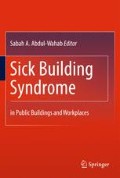Abstract
This chapter presents a systematic method for assessing and improving indoor environmental quality (IEQ) in occupied buildings. The process starts with an occupant satisfaction survey, with recording of perceived IEQ and the health symptoms suffered, to determine the quality and functionality of the building. Technical analysis and physical measurements are conducted in the areas where dissatisfaction and/or health symptom levels are the highest, in order to find out the reasons behind dissatisfaction and to introduce a corrective action plan. The quality of the process is then measured via a post-action satisfaction survey and physical measurements. An IEQ certificate may be granted as proof of the building management’s commitment to occupant well-being. Via implementation of a continuous and proactive indoor environment management process, quality problems are prevented, well-being and productivity of occupants are enhanced, facility risks are better managed, and lease periods will be guaranteed when occupants do not terminate the tenancy because of indoor environment problems.
Access this chapter
Tax calculation will be finalised at checkout
Purchases are for personal use only
References
Andersson K (1998) Epidemiological approach to indoor air problems. Indoor Air 8(S4):32–39.
BOMA (1999) What Office Tenants Want: Building Features, Amenities and Services. Building Owners and Managers Association and Urban Land Institute, Washington, DC.
EN ISO (2004) Acoustics — Field measurements of airborne and impact sound insulation and of service equipment sound — Survey method. International Organization for Standardization, 10052:2004, Geneva.
Engvall K, Norrby C, Sandstedt E (2004) The stockholm indoor environment questionnaire: a sociologically based tool for the assessment of indoor environment and health in dwellings. Indoor Air 14:24–33.
European Committee for Standardization (CEN) (2002) Light and lighting – Lighting of work places – Part 1: Indoor work places, CEN EN 12464–1.
Haapakangas A, Helenius R, Keskinen E, Hongisto V (2008) Perceived acoustic environment, work performance and well-being – survey results from Finnish offices. In: Proceedings of 9th International Congress on Noise as a Public Health Problem (ICBEN) 2008, pp. 434–441.
ISO/DIS 3382-3 (2010) Acoustics — Measurement of Room Acoustic Parameters — part 3: Open Plan Spaces. International Organization for Standardization, Geneva.
Kaarlela-Tuomaala A, Helenius R, Keskinen E, Hongisto V(2009) Effects of acoustic environment on work in private office rooms and open-plan offices – longitudinal study during relocation. Ergonomics 52:1423–1444.
Norbäck D (2009) An update on sick building syndrome. Curr Opin Allergy Clin Immunol 9:55–59.
Norbäck D, Nordström K (2008) Sick building syndrome in relation to air exchange rate, CO2, room temperature and relative air humidity in university computer classrooms: an experimental study. Int Arch Occup Environ Health 82:21–30.
Reijula K, Sundman-Digert C (2004) Assessment of indoor air problems at work with a questionnaire. Occup Environ Med 61:33–38.
Saari A, Takki T (2008) The indoor condition guarantee procedure and associated lease contract model. Facilities 26:144–156.
Takki T, Virta M (2007) A systematic method for improving indoor environment quality through occupant satisfaction survey. In: Proceedings of Clima 2007, paper ID 1209.
Villberg K, Saarela K, Mussalo-Rauhamaa H, Malmberg M, Haahtela T (2002) Correlation between VOCs emitted from building materials and diagnosed building related symptoms. In: Proceedings of Indoor Air 2002, 2:207–212.
Villberg K, Virta M, Kajaala M, Tuomainen M (2008) Occupant satisfaction survey as a tool to improve IEQ: a case-study in a hospital. In: Proceedings of Indoor Air 2008, paper ID 892.
Virjonen P, Keränen J, Hongisto V (2009) Determination of acoustical conditions in open-plan offices – proposal for new measurement method and target values. Acta Acustica United with Acustica 95:279–290.
Zagreus L, Huizenga C, Arens E, Lehrer D (2004) Listening to the occupants: a web-based indoor environmental quality survey. Indoor Air 14(Suppl. 8):65–74.
Acknowledgments
The authors thank Jorma Lehtovaara, M.Sc., from the Aalto University School of Science and Technology for consulting on lighting issues. The Academy of Finland, Research Council for Natural Sciences and Engineering (grant 130187), is acknowledged for financial support.
Author information
Authors and Affiliations
Corresponding author
Editor information
Editors and Affiliations
Rights and permissions
Copyright information
© 2011 Springer Berlin Heidelberg
About this chapter
Cite this chapter
Takki, T., Villberg, K., Hongisto, V., Kosonen, R., Korpi, A. (2011). A Continuous and Proactive Process to Enhance Well-being Indoors. In: Abdul-Wahab, S. (eds) Sick Building Syndrome. Springer, Berlin, Heidelberg. https://doi.org/10.1007/978-3-642-17919-8_19
Download citation
DOI: https://doi.org/10.1007/978-3-642-17919-8_19
Published:
Publisher Name: Springer, Berlin, Heidelberg
Print ISBN: 978-3-642-17918-1
Online ISBN: 978-3-642-17919-8
eBook Packages: EngineeringEngineering (R0)

